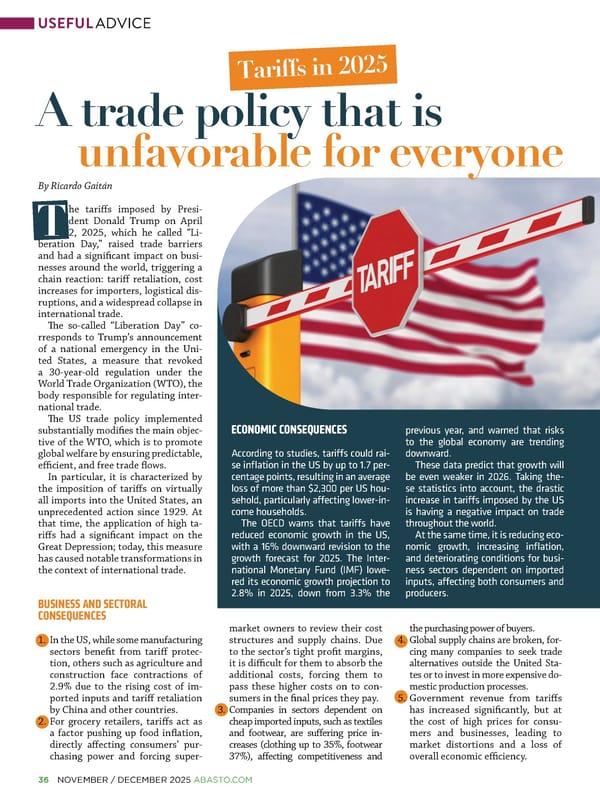36�NOVEMBER / DECEMBER 2025 ABASTO.COM Tariffs in 2025 market owners to review their cost structures and supply chains. Due to the sector’s tight proft margins, it is difcult for them to absorb the additional costs, forcing them to pass these higher costs on to con- sumers in the fnal prices they pay. 3. Companies in sectors dependent on cheap imported inputs, such as textiles and footwear, are sufering price in- creases (clothing up to 35%, footwear 37%), afecting competitiveness and the purchasing power of buyers. 4. Global supply chains are broken, for- cing many companies to seek trade alternatives outside the United Sta- tes or to invest in more expensive do- mestic production processes. 5. Government revenue from tarifs has increased signifcantly, but at the cost of high prices for consu- mers and businesses, leading to market distortions and a loss of overall economic efciency. ECONOMIC CONSEQUENCES According to studies, tarifs could rai- se inflation in the US by up to 1.7 per- centage points, resulting in an average loss of more than $2,300 per US hou- sehold, particularly afecting lower-in- come households. The OECD warns that tarifs have reduced economic growth in the US, with a 16% downward revision to the growth forecast for 2025. The Inter- national Monetary Fund (IMF) lowe- red its economic growth projection to 2.8% in 2025, down from 3.3% the previous year, and warned that risks to the global economy are trending downward. These data predict that growth will be even weaker in 2026. Taking the- se statistics into account, the drastic increase in tarifs imposed by the US is having a negative impact on trade throughout the world. At the same time, it is reducing eco- nomic growth, increasing inflation, and deteriorating conditions for busi- ness sectors dependent on imported inputs, afecting both consumers and producers. A trade policy that is unfavorable for everyone By Ricardo Gaitán T he tarifs imposed by Presi- dent Donald Trump on April 2, 2025, which he called “Li- beration Day,” raised trade barriers and had a signifcant impact on busi- nesses around the world, triggering a chain reaction: tarif retaliation, cost increases for importers, logistical dis- ruptions, and a widespread collapse in international trade. Te so-called “Liberation Day” co- rresponds to Trump’s announcement of a national emergency in the Uni- ted States, a measure that revoked a 30-year-old regulation under the World Trade Organization (WTO), the body responsible for regulating inter- national trade. Te US trade policy implemented substantially modifes the main objec- tive of the WTO, which is to promote global welfare by ensuring predictable, efcient, and free trade fows. In particular, it is characterized by the imposition of tarifs on virtually all imports into the United States, an unprecedented action since 1929. At that time, the application of high ta- rifs had a signifcant impact on the Great Depression; today, this measure has caused notable transformations in the context of international trade. BUSINESS AND SECTORAL CONSEQUENCES 1. In the US, while some manufacturing sectors beneft from tarif protec- tion, others such as agriculture and construction face contractions of 2.9% due to the rising cost of im- ported inputs and tarif retaliation by China and other countries. 2. For grocery retailers, tarifs act as a factor pushing up food infation, directly afecting consumers’ pur- chasing power and forcing super- USEFUL ADVICE
 Abasto Magazine November/December 2025 ENGLISH Page 35 Page 37
Abasto Magazine November/December 2025 ENGLISH Page 35 Page 37